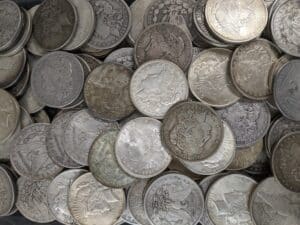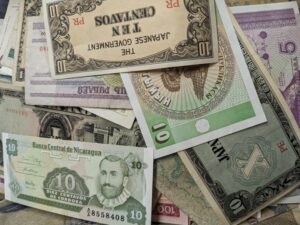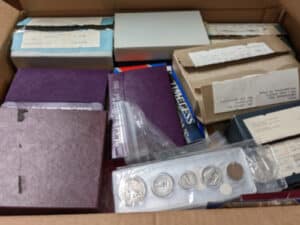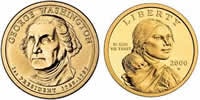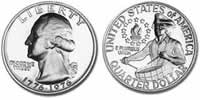Common gold, silver & coin questions
Do you buy all forms of gold? Even my old broken jewelry?
Yes, we buy all forms of gold, silver, and platinum. It can be ugly, old, or broken. It does not matter to us.
Should I clean my dirty coins before selling them?
No, never try to clean a coin, no matter how dirty or ugly it looks. Cleaning damages the coin.
Are old coins rare?
Some are rare, some are not. Almost everything is common. If you think about it, that’s what makes rare stuff rare: the definition of “rare” is “most things aren’t.” Just because you don’t see Buffalo nickels in your pocket change every day, that doesn’t make them rare. Every coin dealer in the country has loads of them. Most older coins usually have at least a few “key dates” that are usually worth more, while the rest of the dates are common for that type of coin.
Are old coins worth a lot of money?
Age alone does NOT make something rare or valuable! Age has almost nothing to do with the value of a coin. Ancient Roman coins can be purchased for $5-$10, whereas a gem 1956 Franklin half dollar recently sold at auction for over $100,000. Rarity and condition are what makes a coin valuable. The combination of both is when the big bucks come into play. Popularity is also a factor, but 99% of all coins in existence are only worth the metal of which they are made (or less).
I found a gold dollar in my change. What’s it worth?
If your “gold coin” looks like this…..
It is not gold and it is worth a dollar. Spend it. If it is not a Presidential or Sacagawea dollar maybe you did find gold. Come visit us during business hours and we will give you a free appraisal.
I found a quarter that says 1776 on it; is it worth anything?
If it looks like this…..
It is United States Bicentennial Coinage. It’s worth a quarter spend it (it’s not from 1776). It is not silver.
I have a bunch of Eisenhower Dollars (beau dollars) what are they worth?
Generally, Eisenhower Dollars are worth one dollar.
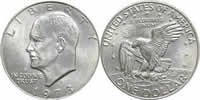
However, the US Mint did make some special silver collector’s issues. If you look on the side of the coin and it has a copper/clad band, it is worth a dollar. If it has no copper band, then you may have a silver one.
I just found a 1943 copper penny!
It is very unlikely that you actually have a real one. They are expensive because they are VERY rare. Many fake 1943 copper pennies exist.
Should I sort my coins by date before bringing them in?
Often, people bring us their coins carefully arranged by date and decade, usually placed in separate Ziploc bags or paper envelopes / coin tubes. You might be tempted to do this, but it’s not worth the effort.
When we appraise a collection, the first thing we do is separate coins by their composition (e.g. copper, nickel, silver, or gold). If you must organize your collection, put it into these groups:
- Gold coins
- 9o% silver dollars (1878 through 1935)
- 9o% silver dimes, quarters, and half dollars (1892 through 1964)
- 40% silver JFK half dollars (1965 through 1970)
- Lincoln Wheat Cents (1909 through 1958)
- Buffalo Nickels (1913 through 1938)
- Jefferson Nickels (1938 and later)
- All other obsolete U.S. type coins
- U.S. Mint proof and uncirculated sets
- U.S. Mint commemorative sets
- Currency and paper money
- Foreign coins / tokens
Are my Hummel figurines worth a lot of money?
China, plates, Hummels, ceramics, and porcelain look pretty, but they are not often worth much more than a couple of dollars.
Should I itemize my coins in a spreadsheet or text document?
More than likely we won’t be able to use it. We will need to see your coins in order to judge their condition and value. No matter how thorough or complete your list may be, we can evaluate your collection faster by going through the coins rather than from your list. So before you decide to go through the time and effort to make a list, please understand that while a list may be useful to you, it won’t be as useful to us. Besides, as part of our appraisal process, we will prepare a written list for you.
Will you buy my foreign coins, even if they are not silver or gold?
Yes, we generally buy them by the pound. We pay $3/lb for foreign base metal coins. Everyone has some foreign base metal (not silver or gold) coins laying around, and banks do not accept coins for exchange value.
Should I remove coins from an album that was assembled by a collector?
Coins that a collector selected and placed in an album have a greater chance of being worth more than their metal value. It is much easier for us to search for key or rare dates in an album than in a heap of coins. If your coins are already in a book, it is best to keep them intact until we can review them.
Why do gold and silver ounces cost more than the spot price I see on tv?
Generally, the price you see for gold is based on one futures contract for gold, that futures contract theoretically controls 100 troy ounces, or one brick of gold (1,000 oz for silver). So if you want that price, you need to open a futures account with the Chicago Mercantile Exchange, and buy the 100 oz of gold or 1,000 oz of silver for future delivery. Paper cash is not accepted. Ironically, you might never actually get a physical delivery. Many gold and silver contracts are settled for (digital) cash, whether you like it or not.
Think of the spot price of gold as a guide correlated with the physical product. Sort of like the price of oil is loosely tied to what you actually pay at the pump. Many factors make up the premiums on physical gold, and these factors constantly change. The spot price is just one of them.
Do you report customer’s buying to the IRS?
All coin shops work with the same AML rules as banks. When cash transactions take place that equal over $10,000 dollars in a given period, we are required to file a currency transaction report (CTR).
Do you report customers selling to the IRS?
No, what you sell is for you to report.
Can I get a loan?
We are not a pawn shop or a bank, so we do not offer loans. We also do not accept electronics, car radios, furniture, or catalytic converters (that’s junk yard stuff).
How old do I have to be to sell to Oakton Coins?
You must be over 18 to sell to us, and you must produce valid identification.
Do you pay more than scrap prices for jewelry?
Yes, sometimes if it’s fashionable (resalable). Designer names help a lot: Tiffany & Co., Georg Jensen, Gucci, David Yurman, etc.
Do I need to make an appointment?
You do not usually need an appointment during normal business hours.
Do you charge for appraisals?
Verbal appraisals are free.
Written appraisals are $20 (refundable with sale of appraised item).
Insurance (inflated) appraisals are $40 an hour with a minimum of $20.
Do you buy ivory?
No. Although it might be technically legal to buy antique ivory pieces, due to political pressures from the U.S., Europe, & now China, ivory has virtually no resale value anymore. So no ivory its time has passed.
What do you buy besides coins, paper money, gold, and silver?
We buy lots of stuff: diamonds, gems, comic books (1960s and before), baseball cards (1960s and before), Star Wars toys (1980s and before), meteorites, stamp collections, pocket watches, and more. If you have something interesting to sell but it’s not for us, we can direct you to a potential buyer.
What geographic region does Oakton Coins serve?
Oakton Coins & Collectibles is centrally located in between downtown Evanston & downtown Skokie. We are very close to the north side of Chicago. We are walking distance from the CTA yellow line Oakton stop and the 97 CTA bus. We offer plenty of free parking in front and more in back. People often visit from Chicago, Rogers Park, Evanston, Lincolnwood, Niles, Park Ridge, Deerfield, Morton Grove, Des Plaines, Glencoe, Highland Park, Glenview, Northbrook, Schaumburg, and more.
Understanding Pricing
Retail: Highest price possible because goods sit around for long periods, includes the costs of labor, property, and taxes.
eBay: The asking price is meaningless. People can ask any crazy price for anything.
Wholesale: How most things trade the price at which a retail seller attained goods.
Insurance appraisal: Fantasy number often based on 3-x retail price or higher.
Futures spot price: Only roughly correlated with the actual price of physical metal, based on a future price of very large contracts: Gold – 100 troy ounces, Silver – 5,000 troy ounces, Platinum – 50 troy ounces.
Wishful-Thinking Pricing: A seller’s idea of how much they would like for an item. You may find listings of a random coin on Etsy, eBay, or someplace easy to list asking a crazy number for it. It never sells, or may be listed “for sale” for years. These prices comes from ignorance, optimism-gone-overboard, and in some cases is an outright joke. They tend to create a lot of confusion for people who are new to selling coins. The Red Book is also usually wishful-thinking pricing.
Clickbait Pricing: Defined by Wikipedia as web content that is aimed at generating online advertising revenue, especially at the expense of quality or accuracy. This pricing relies on sensationalist headlines to attract click-throughs. Click-throughs refer to when the reader clicks the link to go through to the next stage of the bait. Clickbait makers love to post about how common coins could be worth big money, but in reality the validity of their claims is extremely rare.
Real-World Pricing: Actual money changing hands. This pricing reflects prices that have actually been paid, not just advertised. This is the true market value. Everything else is just a bunch of words & ideas about the worth.
Do we sell jewelry (are you a jewelry store)?
We do not sell jewelry to the general public. We are not a jewelry store.
Do you do consignments?
Yes, we do consignments. We can also help with whole estate liquidations / clean-outs in the Skokie Chicago area.

